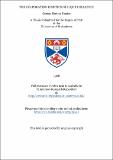Files in this item
The evaporation kinetics of liquid helium II
Item metadata
| dc.contributor.advisor | Osborne, D. V. | |
| dc.contributor.author | Hunter, George Hutton | |
| dc.coverage.spatial | 148 p. | en_US |
| dc.date.accessioned | 2018-06-12T10:39:51Z | |
| dc.date.available | 2018-06-12T10:39:51Z | |
| dc.date.issued | 1968 | |
| dc.identifier.uri | https://hdl.handle.net/10023/13941 | |
| dc.description.abstract | This work is concerned with the evaporation and condensation processes occurring when liquid helium II is in equilibrium with its saturated vapour. We define the condensation coefficient a as the fraction of atoms incident on the liquid vapour interface which cross it to form part of the liquid. Experiments to measure are described, and the results are discussed in terms of microscopic condensation processes. The measurements are made by reflecting second sound pulses from the liquid vapour surface at normal incidence and measuring the reflection coefficient. An account is given of the phenomenological theories of Osborne (1962a) and Chernikova (1964), which describe the reflection of second sound from the surface and the associated effect, its transformation into first sound in the gas. Neither of these agree with the experimental results, and Osborne's theory is modified by taking account of the conditions in the gas a small fraction of a mean free path above the surface (rather than many mean free paths above the surface, as in Osborne's original theory). Thus modified, the theory is shown to be in agreement with the measurements of the reflection coefficient. Also described are measurements made in second sound pulses generated at the interface by first sound pulses, themselves generated at the interface by second sound, propagated up the tube, and reflected from its closed and back to the surface. From the time intervals between these pulses the velocity of first sound in the vapour is deduced, and found to be in agreement with previous work. Measurements of pulse amplitude corroborate the reflection coefficient measurements, and taking the two sets of measurements together wo have concluded that a is probably 1 and not less than 0.8 between 1.0°K and 2.14°K. The microscopic processes by which condensation can take place are considered. Experiments due to beaker (unpublished, see Osborne, 1962a) and Osborne (1962b) are described, which indicate that the vapour exchanges momentum with normal fluid only. We have therefore supposed that processes in which a gas atom condenses to form excitations must conserve energy and momentum. Processes involving both bulk excitations and surface excitations are considered, but effects due to the finite lifetime of the excitations and the linewidth of the excitations spectrum are neglected. No attempt has been made to calculate the matrix elements for condensation processes, but plausible estimates have been made of their relative magnitudes. In particular, only processes involving one gas atom and one or two excitations have been considered. Using the requirements of conservation of energy and momentum, it is shown that as the temperature decreases, a decreasing fraction of the incident atom have enough energy to form two excitations, and condensation must take place by the collision of an atom with an existing excitation. A rough estimate of the collision probability for such a process leads to the conclusion that at 1°K, a should be about 0.2. This disagreement with experiment has not been resolved. Finally, some remarks are made about the implications for other work on liquid helium II, and some suggestions for future work. | en_US |
| dc.language.iso | en | en_US |
| dc.publisher | University of St Andrews | en |
| dc.subject.lcc | QA913.H8 | |
| dc.subject.lcsh | Turbulence | en |
| dc.title | The evaporation kinetics of liquid helium II | en_US |
| dc.type | Thesis | en_US |
| dc.type.qualificationlevel | Doctoral | en_US |
| dc.type.qualificationname | PhD Doctor of Philosophy | en_US |
| dc.publisher.institution | The University of St Andrews | en_US |
| dc.publisher.department | University of East Anglia | en_US |
This item appears in the following Collection(s)
Items in the St Andrews Research Repository are protected by copyright, with all rights reserved, unless otherwise indicated.

